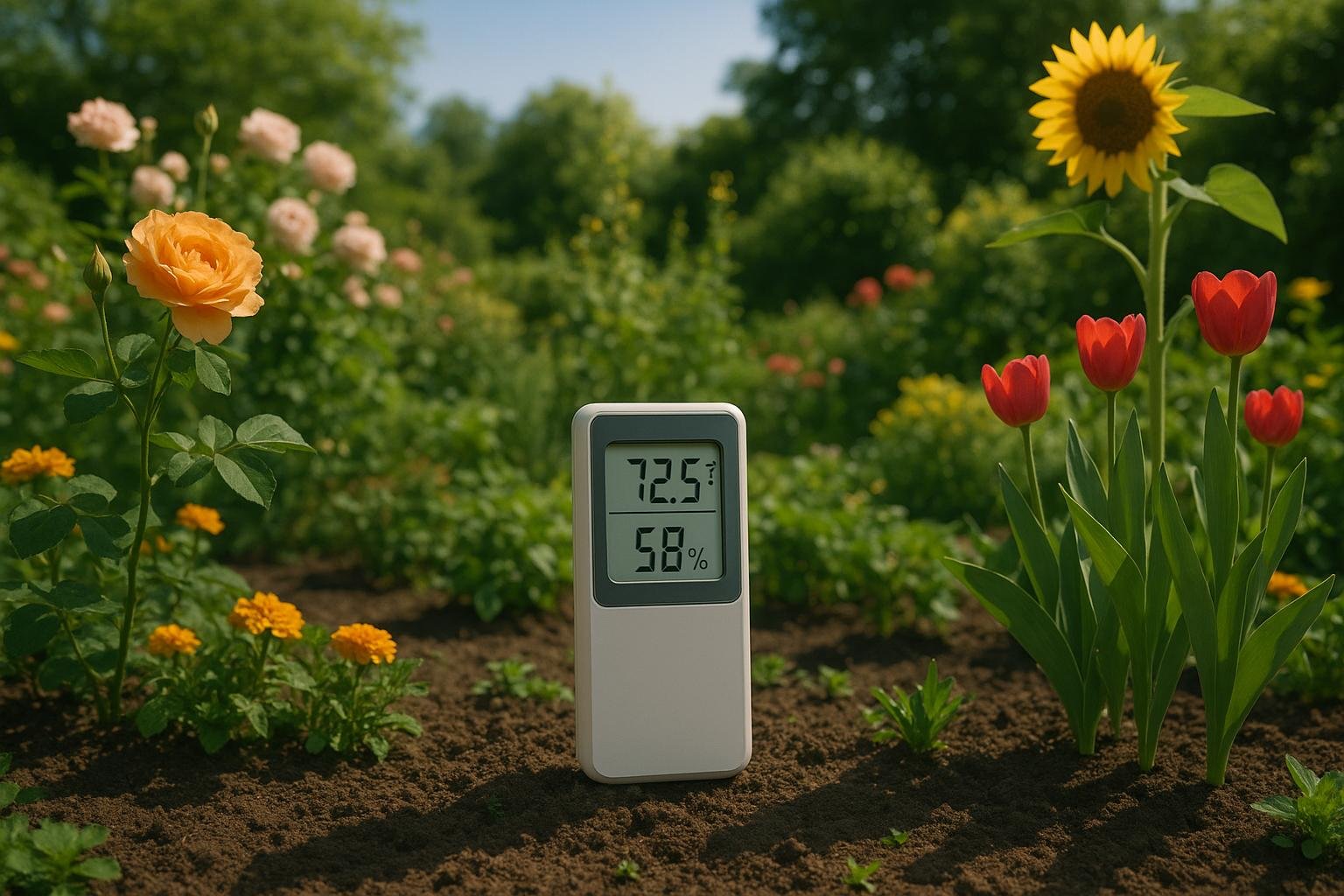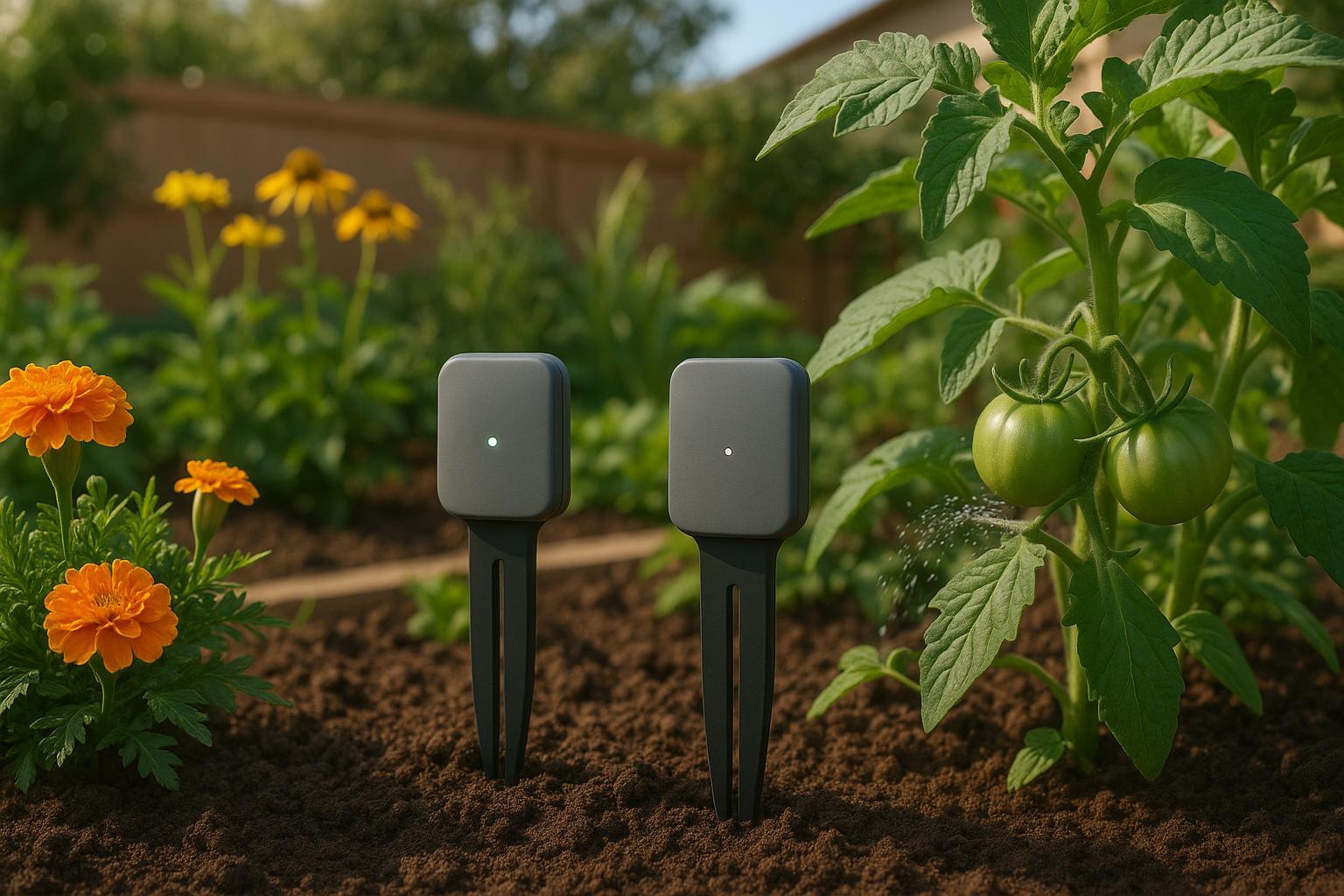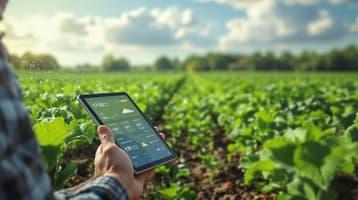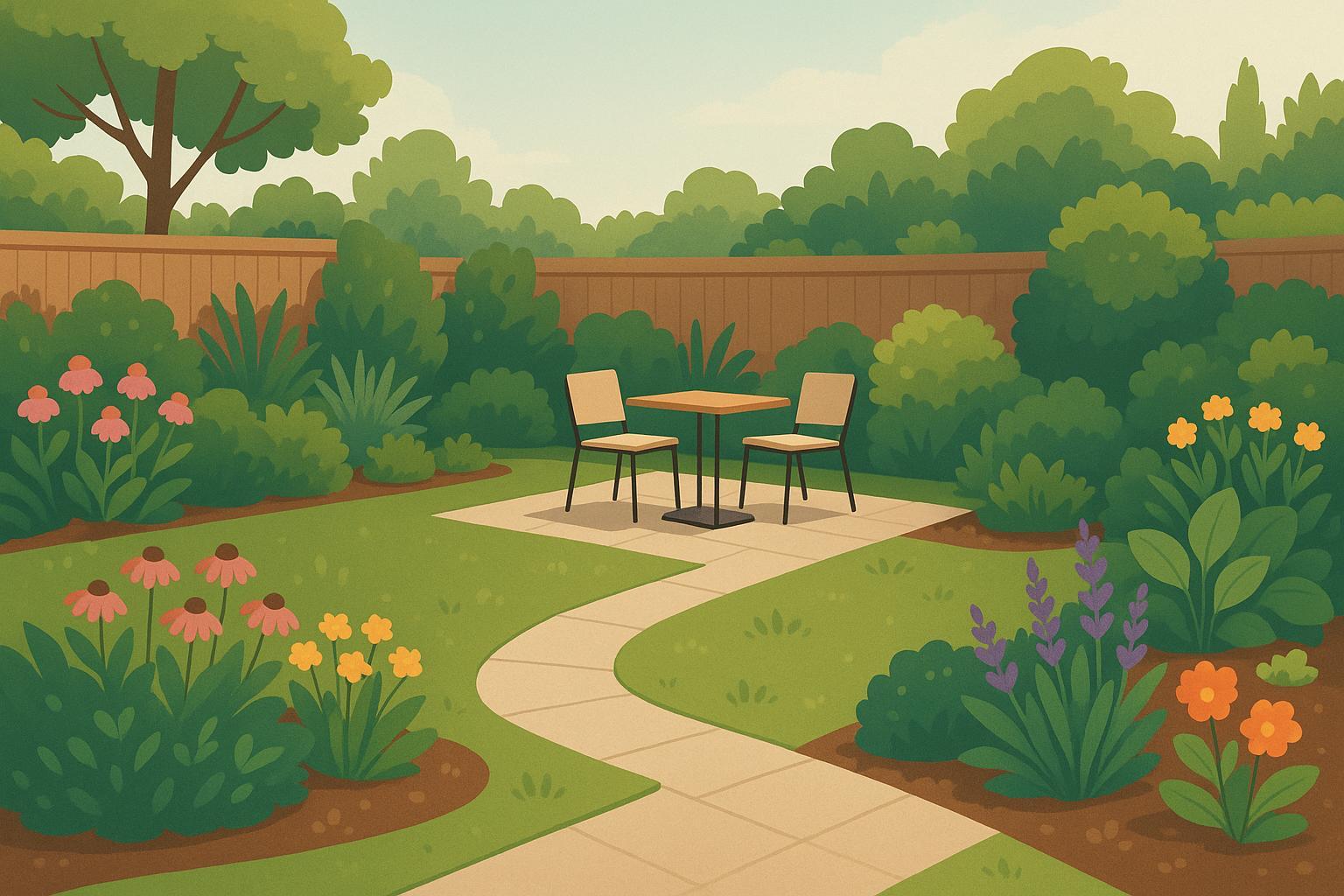AI Tools for Managing Temperature Swings in Gardens

Managing sudden temperature changes in your garden just got easier with AI tools. These technologies help monitor, predict, and adjust to temperature swings, protecting your plants and improving their health. Here's how AI can help:
- Real-time monitoring: Sensors track temperature, soil, and plant conditions.
- Predictive insights: AI forecasts upcoming weather changes to prepare your garden.
- Automated adjustments: Smart systems manage watering, shading, and frost protection.
Temperature extremes - like frost or heatwaves - can harm plants, slowing growth or causing stress. AI tools, such as smart sensors and weather forecasting systems, ensure your garden thrives by keeping conditions stable. They also recommend the best plants for your local climate and create planting schedules to avoid stress periods.
AI-powered solutions are transforming gardening into a data-driven practice, helping you grow healthier plants while saving water and conserving resources.
Introducing Bloomiee: AI Garden Control System w/ Camera & Sensors

Temperature Swings and Garden Health
Sudden temperature changes can disrupt how plants function, particularly when it comes to cell activity and nutrient absorption. Over the past three decades, winters have warmed by approximately 15°F, shifting many areas by 1.5 hardiness zones. These changes come with increasingly erratic temperature patterns.
Temperature Effects on Plant Growth
Plants thrive within specific temperature ranges, and when conditions stray too far from those ranges, they face stress that can harm their growth and overall health.
"A late frost can kill off the fruit tree buds or snuff out newly planted annuals. Plants undergo cellular freezing that will cause rot when they thaw. In high heat, plant leaves scorch and they may fail to uptake adequate nutrients in hot soil. Extreme heat means plants dry out more rapidly, causing wilt and other symptoms of stress. In a snowless winter, hard freezes damage plant roots in the dry soil. Many weather conditions will influence growth, production, and overall health."
– Bonnie L. Grant, Writer
Here’s how different temperature ranges affect plant health:
| Temperature Range | Effect on Plants |
|---|---|
| Below 55°F | Growth slows or stops |
| 59–86°F | Ideal growth conditions |
| Above 85°F | Growth slows; stress begins |
| Above 90°F | Plants experience significant stress |
| Above 104°F | Critical stress; plants enter survival mode |
For instance, during a spring heatwave in a Canadian temperate deciduous forest, temperatures between 87–91°F over three days caused a 25% drop in leaf production for sugar maples (Acer saccharum Marshall). This showcases how temperature extremes can directly impact plant productivity and highlights the importance of managing garden conditions carefully.
Garden Microclimates
Microclimates within your garden can help buffer plants against extreme temperature swings. These localized climate variations are especially useful as weather patterns become more erratic.
When soil becomes too dry during extreme heat or cold, plants face a host of challenges: photosynthesis slows, roots struggle to develop, and leaves may wilt or discolor due to frost damage. One effective way to combat these issues is by maintaining consistent soil moisture, as moist soil can hold heat longer than dry soil. Additionally, structures like fences and walls can create small protective zones, shielding vulnerable plants from harsh conditions.
AI Temperature Monitoring Systems
AI-based monitoring systems combine real-time sensor data with predictive analytics to protect plants from harmful temperature changes.
Smart Garden Sensors
Smart garden sensors are at the heart of AI-driven temperature management systems. These devices continuously track environmental conditions, providing real-time data to reduce plant stress and create optimal growing environments.
To get the best results, it's essential to place temperature sensors thoughtfully throughout the garden:
| Sensor Placement | Purpose | Placement Tip |
|---|---|---|
| Central Garden Area | Monitors overall temperature | Keep away from structures that could skew data |
| Plant Height Level | Tracks the plant's environment | Use several sensors in larger spaces |
| Protected Locations | Ensures accurate readings | Avoid direct sunlight, vents, and fans |
| Microclimate Zones | Monitors specific zones | Place near sensitive plants or problem areas |
For instance, an advanced AI-powered controller can analyze historical environmental data to make fine-tuned adjustments. This helps optimize photosynthesis and avoids overcorrections that could harm plants.
These sensor insights naturally lead to more advanced weather prediction capabilities.
Weather Forecasting with AI
By building on sensor data, AI-powered weather forecasting tools take temperature prediction to the next level. These systems analyze detailed weather patterns and provide hyperlocal forecasts, allowing gardeners to proactively protect their plants.
The results of AI weather forecasting have been game-changing. A 2022 World Bank report noted that AI-driven tools improved yield predictability by 25% while significantly cutting down on wasted resources.
A real-world example comes from Agrio's monitoring system. Their data showed that weather conditions in 2021 delayed corn development by 18 days - from the 7-leaf stage to 5-inch tassels - compared to 2020. This kind of precise tracking enables gardeners to adjust care routines based on actual plant growth rather than sticking to rigid schedules.
The demand for these technologies is growing rapidly. Projections estimate the IoT weather station market will grow by $29.7 million by 2026, with an annual growth rate of 7.09%. This underscores the increasing reliance on accurate temperature management tools in modern gardening.
"AI isn't just helping farmers respond to climate change; it's helping them anticipate and adapt to it." - E.D. Gibson
🚀 Ready to Reinvent Your Garden?
Join thousands of homeowners who have transformed their gardens using our AI design tool. Upload one photo to explore endless possibilities.
Get your AI garden designs →AI Garden Planning for Temperature Control
AI tools are transforming the way gardens are designed to handle temperature changes. By analyzing both historical and real-time climate data, these systems create garden layouts that can adapt to temperature fluctuations, ensuring plants thrive in varying conditions.
Temperature-Smart Plant Selection
AIGardenPlanner's AI Plant Advisor uses local climate and microclimate data to recommend plants that can handle the challenges of your specific environment. Here's how it works:
| Climate Factor | AI Analysis | Benefit |
|---|---|---|
| Temperature Range | Historical highs/lows | Identifies plants that can survive extreme temps |
| Microclimate Zones | Garden-specific conditions | Matches plants to sheltered or exposed spots |
| Seasonal Patterns | Year-round trends | Suggests the best planting locations |
| Sun Exposure | Daily/seasonal changes | Recommends placement for natural temperature control |
Research backs the effectiveness of this approach. A Cornell University study found that integrating AI into environmental controls cut energy use by 25% while maintaining ideal growing conditions.
"AI-driven services that identify native plants suitable for a user's specific region and living conditions can be helpful."
- Marek Bowers, founder of Bolder Green
These personalized plant recommendations are further enhanced by AI-driven planting schedules.
AI Planting Schedules
AI doesn't just stop at picking the right plants - it also ensures they're planted at the right time. By combining real-time weather data with historical trends, AI creates planting schedules designed to protect plants from temperature stress. Here's what these schedules can do:
- Weather Pattern Analysis and Risk Management: AI examines past weather trends and current forecasts to identify the safest planting windows. It also avoids high-risk periods linked to plant diseases.
- Succession Planning: The system calculates the best planting intervals to prevent temperature stress and ensure a steady harvest throughout the season.
Visualization tools take it a step further by helping gardeners optimize plant spacing. This strategic layout promotes natural shading and wind protection, keeping temperatures more stable. Regular updates make sure your garden stays resilient, even as conditions change.
sbb-itb-4d6a8dd
Smart Temperature Control Systems
AI technology is transforming how gardens handle temperature fluctuations by leveraging real-time monitoring and predictive tools.
Automated Shade and Frost Protection
AI-driven shade systems are designed to respond automatically to changing conditions, helping to maintain optimal temperatures for plants. For instance, a study found that using silver 60% shading nets over avocado trees successfully reduced air temperature from 109.6°F to 104.5°F and leaf temperature from 110.8°F to 103.6°F.
"Thermal screens help insulate houses in the colder months but can also keep houses cooler during summer. The screens are a tremendous energy savings and are now seen by many growers as essential." - Bill Christopher, Heads up international distribution, Gintec
To complement shading solutions, smart irrigation systems play a critical role in maintaining stable garden climates by ensuring optimal soil moisture levels.
Smart Watering Systems
AI-powered irrigation systems take water management to the next level by tailoring distribution based on real-time data. These systems consider factors like soil moisture, current and predicted weather, plant-specific water needs, temperature, and humidity.
Take the fieldWISE platform as an example: it supported 4,500 farmers across 100,000 hectares, leading to water cost savings of 30–50%, a 25% reduction in water usage, and yield improvements of 20–30%. By integrating weather forecasts with real-time climate data, these systems ensure consistent soil moisture, helping plants withstand temperature extremes and thrive even during tough weather conditions.
Conclusion: Next Steps in AI Garden Technology
AI-driven garden management is advancing rapidly, addressing the challenges posed by sudden temperature changes. By 2028, the AI agriculture market is expected to expand from $1.7 billion in 2023 to $4.7 billion, reflecting major progress in smart gardening technologies.
Recent developments include soil sensors capable of autonomously managing watering, temperature, and humidity levels, alongside AI algorithms that help crops adjust to shifting weather conditions.
"AI is really good at making things more efficient; it could remove the frictions of the horticulture industry." - Dr. Daniel Hulme, CEO of Satalia
These innovations are already delivering impressive results. For instance, AI-powered sensors can cut water usage by up to 50%, increase crop yields by 20%, and improve garden design accuracy by 30%. Tools like AIGardenPlanner are leading the way, offering tailored plant recommendations based on local climate data and temperature trends, helping gardeners build resilient and sustainable landscapes.
However, experts remind us to approach AI as a tool rather than an all-encompassing solution. As RHS Botanist Jordan Bilsborrow explains:
"Any AI is only as good as the information being fed into it... So, the information should be treated as guidance, rather than as an absolute".
Looking ahead, the integration of smart greenhouses and AI-powered disease detection systems - boasting over 90% accuracy - signals a future where gardens can intelligently adapt to environmental changes. These advancements promise to transform how we interact with and care for our gardens.
FAQs
How can AI sensors and weather forecasting tools help protect my garden from sudden temperature changes?
🎨 Visualize Your Dream Garden Today!
Transform any outdoor space into a professional landscape design in minutes. Just upload a photo, choose your style, and let our AI do the rest.
Start your garden transformation now →How AI Sensors and Weather Tools Protect Your Garden
AI sensors and weather forecasting tools join forces to keep your garden thriving by offering real-time updates and predictive guidance. Sensors placed in your garden track essential factors like soil moisture, temperature, and humidity. This data is then processed by AI systems to identify potential threats, such as stress from sudden temperature drops. For instance, if a frost is on the horizon, the system can notify you to cover delicate plants or tweak your watering schedule.
Weather forecasting tools take it a step further by predicting upcoming weather patterns and extreme conditions. When combined with sensor data, these forecasts empower you to take timely actions to shield your plants, promoting healthier growth and better resistance to shifting temperatures.
How should I place AI temperature sensors in my garden for the most accurate readings?
For precise temperature tracking, position AI sensors at the same height as your plants' canopy to measure the microclimate they actually experience. Steer clear of placing sensors in direct sunlight or near surfaces like concrete or asphalt that can reflect heat and distort the readings. Make sure the sensors are protected from water spray and strong winds, and keep them within a clear line of sight to the data gateway to maintain a strong connection. As your plants grow or the layout of your garden shifts, adjust the sensor placement accordingly. Regular checks and upkeep will help ensure the data you collect remains accurate and reliable.
How can AI tools help me choose plants suited to my climate and create a planting schedule?
AI tools are a game-changer for choosing plants that suit your local climate and developing customized planting schedules. By examining regional weather trends, soil types, and seasonal shifts, these tools offer tailored plant suggestions to promote healthy growth.
They also create smart gardening calendars that adapt to real-time weather updates. This means you can effortlessly keep track of watering, fertilizing, and other crucial tasks. Whether you're new to gardening or a seasoned pro, these tools help you achieve thriving gardens with less hassle.
Related posts
Related Articles

Ultimate Guide to Passive Cooling for Gardens
Explore natural ways to keep your garden cool using passive cooling techniques like strategic planting, water features, and sustainable materials.

Discover the Serenity: Creating and Maintaining Your Garden of Peace Sample
Explore the benefits of having a garden of peace sample, learn how to choose the right plants, design the layout, maintain it, and enjoy the tranquility it offers.

5 Steps to Merge AI with Cottage Garden Design
Integrate AI into your cottage garden design process with five essential steps for a beautiful and practical outdoor space.

Smart Soil Sensors with Home Assistant
Utilize smart soil sensors with Home Assistant to automate garden watering, enhancing plant health while conserving water efficiently.

How AI Improves Weather-Based Irrigation
AI irrigation systems optimize watering by using real-time weather and soil data, ensuring water savings and healthier plants.

Top 5 AI Garden Design Tools Compared
Explore top AI garden design tools that simplify planning with customized styles, plant recommendations, and budget-friendly pricing.